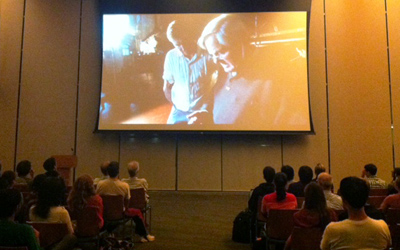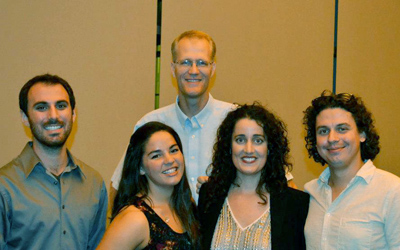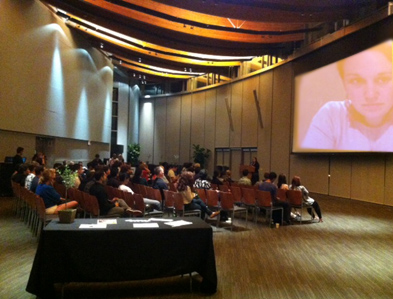
UC San Diego International House Students Express Interest in Cultural Heritage Research
By:
- Doug Ramsey
Published Date
By:
- Doug Ramsey
Share This:
Article Content

Prof. Maurizio Seracini on screen in the National Geographic documentary, "Finding the Lost Da Vinci," in front of an audience of students and alumni of UCSD's International Affairs Group.
When members of UC San Diego’s Center of Interdisciplinary Science for Art, Architecture and Archaeology (CISA3) participated in a program for over 100 graduate and undergraduate students and alumni from various disciplines under the aegis of the university’s International Affairs Group (IAG), both sides came away pledging to continue the interaction.
“This was a very enjoyable event with one of the most inquisitive crowds that I have seen thus far,” said CISA3 director Falko Kuester, who also leads a National Science Foundation-funded program to groom interdisciplinary experts in cultural heritage diagnostics and conservation. “We have an ongoing need to bring the best students into this program, and it was great to see how many of the attendees came up to us afterwards to ask how they too could get involved.”
A highlight of the program was the first public screening for students of a National Geographic documentary profiling the search for a lost Leonardo da Vinci masterpiece by CISA3 and its founding director, Maurizio Seracini (UCSD Class of ’73). In addition to Seracini and Kuester, several graduate students also appeared in the documentary – and were on hand for the discussion afterwards. They included Vid Petrovic and David Vanoni, as well as Samantha Stout (who dialed in from Florence over Skype).
Jacobs School of Engineering graduate students Petrovic and Vanoni (Computer Science and Engineering) and Stout (Mechanical and Aerospace Engineering) are Fellows of the NSF Integrated Graduate Education, Research and Training (IGERT) project led by Structural Engineering professors Kuester and Seracini. The five-year IGERT is focused on interdisciplinary Ph.D. research related to engineering and diagnostics for understanding and safeguarding cultural heritage.

CISA3 director Falko Kuester (in back) with (l-r) UCSD Ph.D. student David Vanoni, IAG event organizer Alexsandra McMahan, SAPER international outreach director Anna Gabriele, and UCSD Ph.D. student Vid Petrovic. Vanoni and Petrovic are Fellows in the NSF-funded IGERT program led by Prof. Kuester.
“As the event ended, the Ph.D. students and Dr. Kuester remained in the Great Hall for over an hour, talking with students and discussing their work,” noted organizer Alexsandra McMahan, the 2012-2013 IAG Fellow (IAG is a programming series under the purview of UCSD’s International House). “It’s moments like those that show just how enthusiastic UC San Diego students can be about interdisciplinary approaches to these incredible challenges.”
IAG provides extra learning opportunities for American and international students interested in the global community, and the Oct. 8 evening program kicked off its 2012-13 lecture series. The evening began with a mixer and reception, followed by a screening of the National Geographic documentary, “Finding the Lost da Vinci.” The hour-long program followed more than three years in the life of CISA3’s search for da Vinci’s mural, “The Battle of Anghiari.” The mural disappeared from the main hall of Florence’s Palazzo Vecchio more than 450 years ago, and Seracini believes it is still there, hidden behind a brick wall erected when the hall was renovated in the mid-16th century.
(For more on the project, click here to watch streaming video of Seracini’s talk in June to the prestigious TEDGLOBAL conference in Edinburgh, Scotland.)
After the screening, CISA3 also showed a short video produced by the California Institute for Telecommunications and Information Technology (Calit2). The video included important research findings announced after the National Geographic finished production on the documentary. Among those findings: the UCSD research team discovered red flakes inside the wall that were organic – in a place where organic material normally should not be found. Other images showed a beige material inside the wall that could only have been applied with a paint brush. Most importantly, the probe retrieved a sample of black material inside the wall that, with the help of a scanning electron microscope, proved to have a chemical composition similar to a black pigment found in brown glazes used on the “Mona Lisa”.

Ph.D. student Samantha Stout participated in the Q&A session via Skype from Florence, where she is continuing work on her research as part of the IGERT program on engineering for cultural heritage.
“The results are very encouraging,” Seracini said in May. “But a lot more work needs to be done to prove the existence and current condition of The Battle of Anghiari beyond a shadow of a doubt.”
“The National Geographic documentary was a phenomenal way to introduce students to the power of UC San Diego programs,” observed McMahan. “As I looked around the room midway through the film, every face I saw was captivated by the rich story being told of the work being done by students and faculty under Maurizio Seracini's leadership.”
After the videos, CISA3’s Kuester briefed the crowd on other projects that are part of CISA3, followed by a question-and-answer session that included his graduate students Vid Petrovic, David Vanoni and Samantha Stout (the latter via Skype). Prof. Seracini had recorded a video message for the audience, but technical problems ensued.
Seracini is now Director of a new UCSD initiative to create a center in Florence in collaboration with the Region of Tuscany. Scienziati Americani per Eccellenza Regionale (SAPER) translates into English as American Scholars for Regional Excellence. The center would focus on developing partnerships in engineering and medicine between Italian and UCSD researchers, while also providing a home base for CISA3 cultural heritage projects in Italy (which will continue to be led by Prof. Seracini).
Representing SAPER at the event was Anna Gabriele, SAPER’s Director of International Outreach in the Jacobs School of Engineering, who helped set up the IAG event. “The participation of Falko, Vid, David and Samantha was a significant part of this event's success, based on the responses we heard from attendees,” said Gabriele. “It is very important for the student community to engage with the graduate students who are working on these exciting projects. Many of the attendees also approached me that evening wanting to learn more about how they could get involved with engineering for cultural heritage (via CISA3 and SAPER) and engineering for medicine (SAPER)."
Added Gabriele: “The audience asked a lot of questions, and many were in the queue when we had to end the program due to a time restriction. However, that did not stop eager students from wanting to learn more, and they gathered around Falko, Vid and David for a good hour after the event had formally concluded.”
In addition to IAG Fellow Alexsandra McMahan, who introduced the documentary, SAPER’s Gabriele worked with a team of people from International House, including acting Interim Director Alan Houston, events coordinator Adam McKinney, program coordinator Maria Lourdes (Malou) Amparo, and facility monitors Salem Hawatemh and Holly Hathrell. She had also worked with previous I-House administrators who have since left UCSD, including then-Interim Director Ahren Crickard, Alumni Relations Coordinator Melissa Brouwer, and IAG Fellow/Intern Jenny Wanninger.
The turnout for the International Affairs Group event convinced CISA3 and SAPER personnel that, going forward, it is critical to engage a broader community of students – and perhaps to extend these outreach opportunities to younger students, including junior and high school students.
“At the very least,” adds SAPER’s Gabriele, “such events allow us to inform communities, but also to inspire, engage, and give back to communities.”
Share This:
You May Also Like
Stay in the Know
Keep up with all the latest from UC San Diego. Subscribe to the newsletter today.


